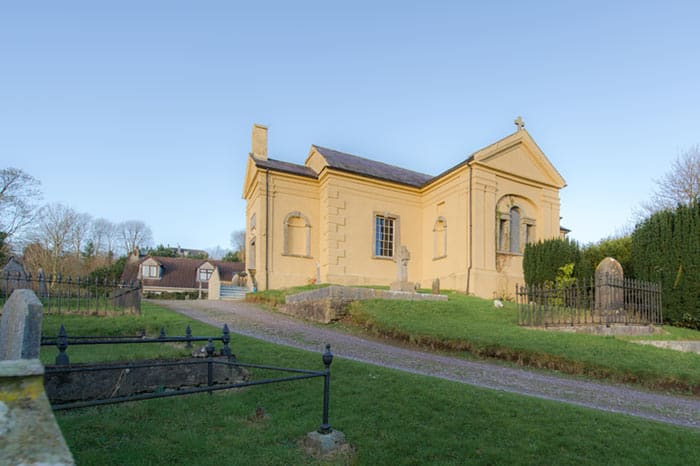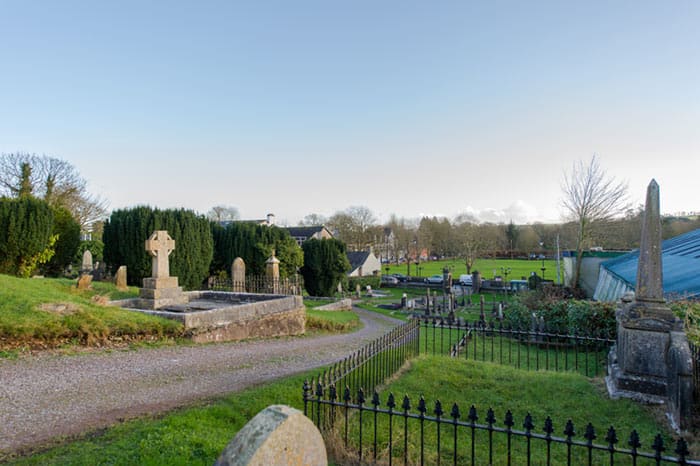Stop 9. Church of Ireland Church of the Resurrection
History

Regardless of the fact that the majority of the population were Catholic, the Protestant church was a very important part of life in Blarney. Work commenced on the church in 1776, shortly after the village had been built so the church you see before you will be 250 years old in 2026.
Design
Unlike so many of the Gothic churches, this church built in 1776 is a more classical design. Big windows let in the light. Although not obvious from the ground; from above you would see the full length of the nave and the transepts and how the church is actually shaped like a cross.
Upstairs/Downstairs
There’s a very close link between this church and the members of the families who own/owned Blarney Castle.
The Jefferyes and later the Colthursts (owners of Blarney Castle) worshipped here. It is also their burial place and the red door you see straight ahead of you at the end of the path of Yew Trees is the entrance to their family crypt located beneath the church.
The general congregation came in through the main door. The working classes would catch a glimpse of the latest fashions and the richer families as they went to and from their worship. No doubt there was plenty of gossip involved!
If you go around to the back of the church, you will notice a set of steps going up to the second floor. That was the private entrance for the Jefferyes/Colthursts. They went to church through that entrance and up the stairs to their private balcony that overlooked the front of the church and the altar. It also had a fireplace to keep them warm during the service! The balcony gallery still has a lot of plaques in memory of various members of the Colthurst family.
Switching Religions!
There was growing resentment at the cost of fees charged by the Catholic clergy for marriages, baptisms, station fees and so on. There was no local Catholic church at the time and so mass was held in various houses but at a fairly substantial cost! The people went on strike. Encouraged by Sir John Colthurst and Lady Jefferyes, the Catholics came en masse down here to this Protestant church. The remarkable thing was that it would have been unheard of in a place like Ireland ruled by the Catholic clergy for the Catholics to abandon their own church and come down to the Protestant church. Eventually it took a Capuchin priest from Cork, a Father Arthur O’Leary, to come out and persuade the people to return to their own church. The bishops had to step in and regulate fees!
Feasts & Famine
In November 1846 Louisa Jefferyes, the only daughter of the Jefferyes who owned Blarney Castle, married George Colthurst from Ardrum, Inniscarra, uniting the two main families of mid-Cork.
The wedding took place in the worst time of the Famine. November 1846 was when the potatoes failed for the second time and people were utterly destitute. The wedding by comparison was a lavish banquet. It is told that there were tar barrels blazing all the way out from Cork City and a massive celebration took place to mark the event.
Blarney was more protected from the famine than other areas. The Jefferyes had previously evicted a lot of their tenants, enabling them to consolidate their small farms into larger farms and pay agricultural labourer’s wages rather than giving them potato plots. Between the Mahony’s who owned the mills and the Jefferyes/Colthurst families, they were able to step in and provide relief when the crops failed, whereas other areas were slow to step up or didn’t have the means to do so.
When Louisa’s father died in 1862 the lands then passed to the Colthurst’s signifying a remarkable succession from Sir James Jefferyes in 1703 right down to Sir Charles Colthurst of the present day.
What’s there today is only a fraction of what used to be the Colthurst estate which extended to lands in Ballyvourney.
Grave Matters
There was a full survey of this graveyard done by Richard Henchion very recently where he goes through every grave and gives the family history.
There is a World War I grave in this churchyard.
Some of the graves here are associated with the early linen industries.
Also a lot of people buried here died in ‘The Hydro’ in St. Anne’s. This was a kind of a spa where they had a water cure and a luxury hotel as well as retirement houses in the area. See here for more info on the hydro.
Our next stop tells us about a vintage car museum and a coaching inn.


